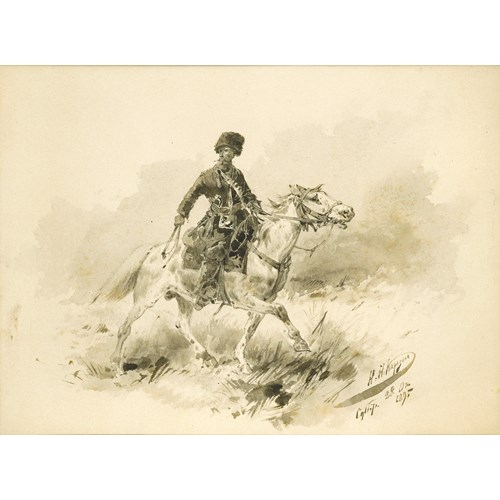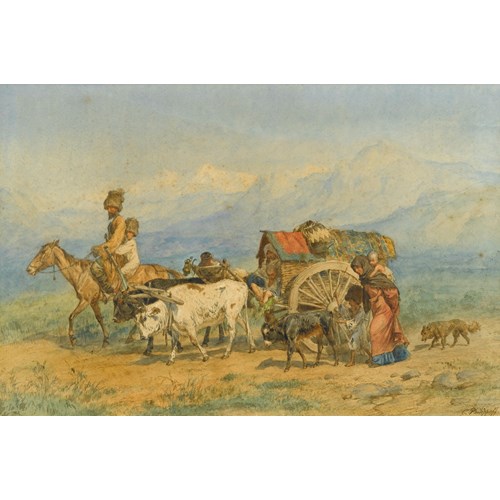Marketplace
The Departure & The Farewell
Count Xavier de Maistre
The Departure & The Farewell
Period 1750-1850, 18th century, 19th century
Origin Russia
Medium Oil on paper laid on panel
Dimension 23.5 x 30.5 cm (9¹/₄ x 12 inches)
In this pair of coastal scenes Count Xavier de Maistre conveys two very different moods and atmospheres. The Farewell is shrouded in a dense, dank mist. The scene feels sombre and eerie, as the viewer struggles to penetrate the thick fog that has rolled in from the sea. A gentleman is being rowed to the ship that is anchored in the bay, and he stands, waving farewell to his loved ones, as they remain on the shore. For one woman the parting is overwhelming, and she has turned away, head in hands. In the centre of the work a figure strolls along the beach with his dog, warmly dressed against the coastal winds, seemingly oblivious to the emotional scene behind him. The human elements of the scene are, however, of secondary importance, to de Maistre’s rendering of the murky sky, which dominates the composition. It is a skilful and studied depiction of a dark cloudy sky, through which the bright glare of the sun struggles to break through, and the sense of muggy drizzle is palpable. The gloom enveloping the landscape accords with the sadness of the farewell.
In contrast The Departure is bathed in warm sunshine, as the dark clouds of The Farewell drift off to the right-hand side. On this clearer day, one can see far across the calm, sunlit bay to the mountainous silhouettes in the background. De Maistre balances bright blues, yellows and whites in the work, as opposed to the more monochromatic, unifying colour scheme of The Farewell. Thus as a pair, the works demonstrate de Maistre’s ability to manipulate colour, and to capture continuously shifting state of the weather.
De Maistre spent much of his life living and working in Russia, and so would have been acutely aware of the early work of the great marine painter Ivan Konstantinovich Aivazovsky (1817-1900), the master of painting the sea in all its states. In his work The Bay of Naples on a Misty Morning, Aivazovsky has also tried to convey the effect of a dank mist on the shore. In a manner comparable to The Farewell, Aivazovsky depicts a small portion of the foreground with great clarity, whilst shrouding the rest of the picture in a haze, so that one can only just make out the shapes of ships and mountains.
In addition to his ‘singular talent for landscape painting’ de Maistre was an accomplished soldier, scientist and writer, earning eternal recognition for his contribution to French literature.¹ He was born in Savoy and as a young man joined the army of Piedmont-Sardinia. His brother was the famous philosopher and counter-revolutionary Joseph de Maistre (1753-1821), and when Savoy became annexed to France in 1792, Xavier, sharing his brother’s political views, left for Russia, where he remained for most of his life. In Russia he took up a commission and served under Alexander Suvorov, but when the general became disgraced, de Maistre’s reputation was also tarnished. It was at this point that de Maistre really devoted himself to painting, particularly to landscapes, in order to support himself. Amongst his works is a portrait of Alexander Pushkin (1799-1837) as a small child. Le Maistre soon regained his place in society and continued his highly successful career as a writer and soldier. He is best remembered today for his novel Voyage autour de ma Chambre (‘Journey around my Room’). The book is an account of the thoughts of a young officer, who is confined to his room for 44 days, and is considered a ‘most brilliant tours de force...remarkable for its lightness, grace and charm’.² De Maistre wrote the book when he himself was under arrest in Turin as the consequence of a duel, and it is the crowning achievement of his outstanding career in the arts.
1 The New Monthly Magazine, vol.XII, no. 71, (December 1st, 1819), p. 521.
2 The World’s Greatest Books, ed. Arthur Mee and John Hammerton, vol VI, (BiblioBazaar, 2008), p.139.
In contrast The Departure is bathed in warm sunshine, as the dark clouds of The Farewell drift off to the right-hand side. On this clearer day, one can see far across the calm, sunlit bay to the mountainous silhouettes in the background. De Maistre balances bright blues, yellows and whites in the work, as opposed to the more monochromatic, unifying colour scheme of The Farewell. Thus as a pair, the works demonstrate de Maistre’s ability to manipulate colour, and to capture continuously shifting state of the weather.
De Maistre spent much of his life living and working in Russia, and so would have been acutely aware of the early work of the great marine painter Ivan Konstantinovich Aivazovsky (1817-1900), the master of painting the sea in all its states. In his work The Bay of Naples on a Misty Morning, Aivazovsky has also tried to convey the effect of a dank mist on the shore. In a manner comparable to The Farewell, Aivazovsky depicts a small portion of the foreground with great clarity, whilst shrouding the rest of the picture in a haze, so that one can only just make out the shapes of ships and mountains.
In addition to his ‘singular talent for landscape painting’ de Maistre was an accomplished soldier, scientist and writer, earning eternal recognition for his contribution to French literature.¹ He was born in Savoy and as a young man joined the army of Piedmont-Sardinia. His brother was the famous philosopher and counter-revolutionary Joseph de Maistre (1753-1821), and when Savoy became annexed to France in 1792, Xavier, sharing his brother’s political views, left for Russia, where he remained for most of his life. In Russia he took up a commission and served under Alexander Suvorov, but when the general became disgraced, de Maistre’s reputation was also tarnished. It was at this point that de Maistre really devoted himself to painting, particularly to landscapes, in order to support himself. Amongst his works is a portrait of Alexander Pushkin (1799-1837) as a small child. Le Maistre soon regained his place in society and continued his highly successful career as a writer and soldier. He is best remembered today for his novel Voyage autour de ma Chambre (‘Journey around my Room’). The book is an account of the thoughts of a young officer, who is confined to his room for 44 days, and is considered a ‘most brilliant tours de force...remarkable for its lightness, grace and charm’.² De Maistre wrote the book when he himself was under arrest in Turin as the consequence of a duel, and it is the crowning achievement of his outstanding career in the arts.
1 The New Monthly Magazine, vol.XII, no. 71, (December 1st, 1819), p. 521.
2 The World’s Greatest Books, ed. Arthur Mee and John Hammerton, vol VI, (BiblioBazaar, 2008), p.139.
Period: 1750-1850, 18th century, 19th century
Origin: Russia
Medium: Oil on paper laid on panel
Signature: One signed 'X de Maistre' (lower centre).
Dimension: 23.5 x 30.5 cm (9¹/₄ x 12 inches)
More artworks from the Gallery









